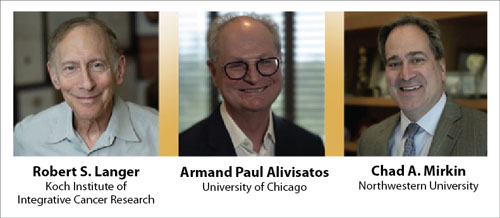NanoBCA Congratulates 2024 Kavli Prize Winners in Nanoscience
Posted on June 13th, 2024 | No Comments »
The NanoBusiness Commercialization Association (NanoBCA) would like to congratulate the recipients of the 2024 Kavli Prize in Nanoscience: Robert S. Langer, Armand Paul Alivisatos, and Chad A. Mirkin. I have had the honor of meeting all three of these distinguished scientists from our Nanotechnology Community.

The 2024 Kavli Prize Laureates in the fields of astrophysics, nanoscience and neuroscience were announced this week by the Kavli Foundation. The Kavli Prize in Nanoscience was awarded to Langer, Alivisatos, and Mirkin “for pioneering work integrating synthetic nanoscale materials with biological function for biomedical applications.” You can watch a 20-minute video of the Kavli Prize announcement here.
The 2024 Kavli Prize in Nanoscience honors Robert S. Langer, Armand Paul Alivisatos and Chad A. Mirkin who each revolutionized the field of nanomedicine by demonstrating how engineering nanoscale materials can advance biomedical research and application. Their discoveries contributed foundationally to the development of therapeutics, vaccines, bioimaging and diagnostics.
“The three scientists, Langer, Alivisatos and Mirkin, have broadened the scientific field of nanoscience, building from fundamental research. By scientific curiosity they have become inventors for the future of nanoscience and biomedicine,” stated Bodil Holst, Chair of the Nanoscience Committee.
Robert S. Langer was the first to develop nano-engineered materials that enabled the controlled release, or regular flow, of drug molecules. This capability has had an immense impact for the treatment of a range of diseases, such as aggressive brain cancer, prostate cancer and schizophrenia. His work also showed that tiny particles, containing protein antigens, can be used in vaccination, and was instrumental in the development of the delivery of mRNA vaccines.
Armand Paul Alivisatos demonstrated that semiconductor nanocrystals, or quantum dots (nanoparticles that possess bright, size-dependent light-emitting properties), can be used as multicolor probes in bioimaging. Essential to this achievement was the synthesis of biocompatible nanocrystals. Semiconductor nanocrystals became the basis for the widely used research and diagnostic tools such as live cell tracking, labelling and in vivo imaging.
Chad A. Mirkin engineered spherical nucleic acids (SNA) using a gold nanoparticle as the core, and a cloud of radially distributed DNA or RNA strands as the shell. He was then able to show how SNAs can be combined to create larger structures and how they can be used in biodiagnostics. His discovery led to the development of fast, automated point-of-care medical diagnostic systems.
Once again, we would like to congratulate Robert S. Langer, Armand Paul Alivisatos, and Chad A. Mirkin for their enormous contributions to our Nanotechnology Community.




